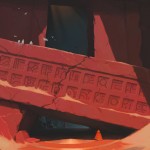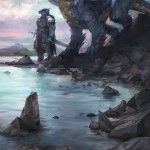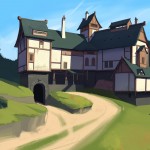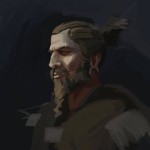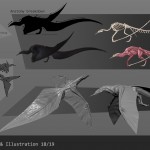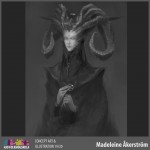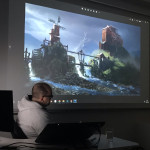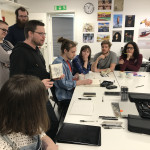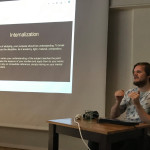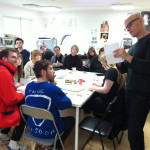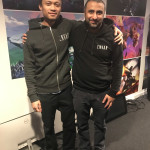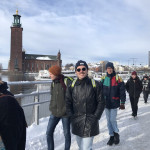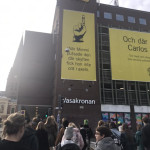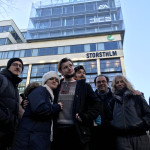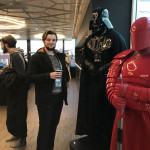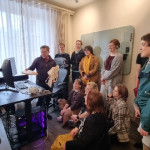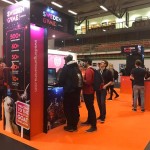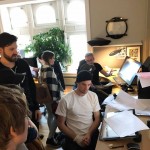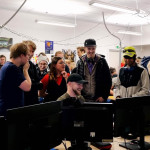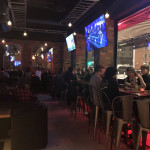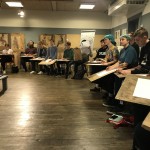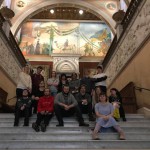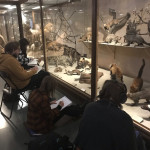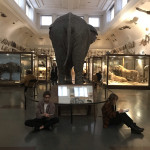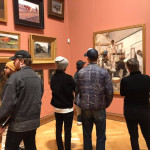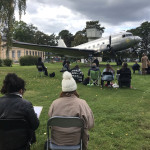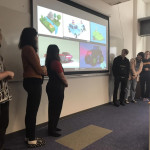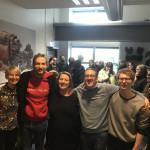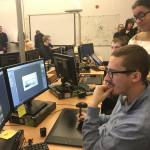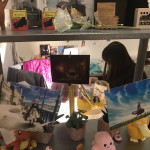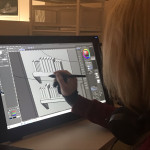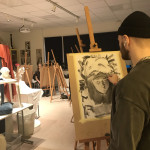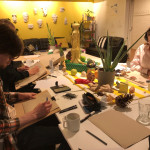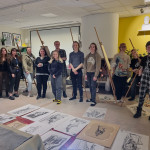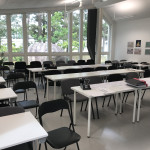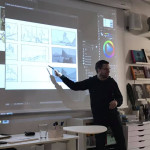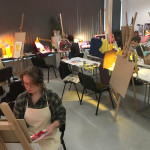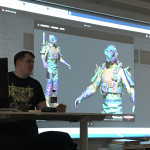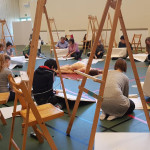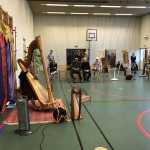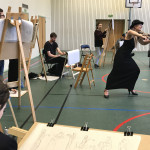
CONCEPT ART & ILLUSTRATION 2 – Portfolio Year
- Length: 1 year
- Class size: About 5 participants
- Apply with: Portfolio, letter of intent and grades from high school or university (or other documents of merit)
PURPOSE OF THE COURSE
The portfolio year is for those of you who are ready to take the next step – to create a portfolio and present your work in order to work on projects in the Entertainment Arts or seek further professional training.
50% CURRICULUM + 50% PORTFOLIO WORK
The Portfolio Year is an offshoot of Year 2. Half of the time you select and attend courses from the course selection for Year 2 and the other half of school time is devoted to your own projects linked to your portfolio. You belong to the Year 2 class and share a studio room with others from Year 2 and the Portfolio Year.
By choosing the courses you want to attend, you create your own curriculum for the year. The choice of courses should reflect the direction you want to take in your portfolio and you can adapt the assignments given in the courses to a certain extent to suit your portfolio projects.
The students in Portfolio Year meet regularly with each other and their teachers/mentors for discussion and feedback, as well as participating in monthly group briefings with their Portfolio Year classmates. You also have access to all guest teachers, workshops and study trips available at school.
MENTORSHIP AND INTERNSHIP
A special feature of this course is that students have the opportunity to acquire one or more outside mentors who are practicing in the field of their specific interest. The school offers each student the ability to pay for mentorships (with a limited amount), although many mentors are known to offer their time free of charge. It is the students responsibility to contact mentors and negotiate how they will meet and how often. The mentor then bills the school directly.
It is also possible to apply for internships at game studios, for example, while studying with us, for up to 10 weeks. Again, it is the students responsibility to seek out and apply for internships.
Curriculum year 2 – you choose about 16 weeks

FOR WHOM?
The course is aimed at those who have very strong basic knowledge in fundamentals and concept art and illustration. You must have skills equivalent to those you get after completing years 1 and 2 at Concept Art & Illustration. The course involves a lot of freedom under responsibility and is highly individualized, which requires you to have a strong drive, good work ethic and clear goals for taking the course. Of those who apply for the portfolio year from CA 2 – we choose those who have demonstrated these qualities, had good attendance, developed and who we think have development potential going forward and the conditions to work in entertainment arts.
GÄSTLÄRARE OCH FÖRELÄSARE
Under året tar vi löpande in gästlärare och föreläsare som är yrkesverksamma inom spel- och illustrationsbranschen. Detta ger insikt i yrken och möjliga vägar vidare inom spelutveckling, 2- och 3-D-grafik, illustration, serieskapande, animation m.m. De senaste åren har vi haft glädjen att möta:
GUEST TEACHERS AND LECTURERS
During the year, we regularly take in guest teachers and lecturers who are professionals in the game and illustration industry. This gives insight into professions and possible paths forward in game development, 2- and 3-D graphics, illustration, comic creation, animation, etc. In recent years we have had the pleasure of meeting:
- Johan Egerkrans (Illustration)
- Simon Stålenhag (Freelance illustration etc)
- Even Mehl Amundsen (Freelance illustration etc)
- Atey Ghalian (Illustration & concept art, CEO Envar studios)
- Thomas Chamberlain-Keen (Illustration & concept art )
- Martin Bergqvist (Concept art)
- Simon Fetscher (Concept art Mood Visuals)
- Mikael Eriksson (Concept art Goodbye Kansas)
- Alexander Forsberg (Freelance illustration)
- Viktor Becker (AD/Concept Art– Zoink Games)
- Henrik Rosenborg (Freelance illustration)
- Veronika Fedorova (Freelance illustration)
- Mattias Adolfsson (Freelance illustration)
- Daniel Jonsson (Character 3D-artist Machine Games)
- Louise Meijer (Concept artist and Art director)
- Pontus Ullbors (AD & Concept art Landfall games + Freelance illustration)
- Anders Larsson (2D-graphics, UI, Fatshark)
- Nicolas Krizan (Illustration)
- Linda Chuu Bjurhager (2-D-animation, storyboarding)
- Leopold Baranowska (Vis dev, storyboard m.m.)
- Gabor Steizinger (animation)
- Andrea De Dominics (Concept art)
- Ellen Barkin Söderholm (Freelance Illustration)
STUDY VISITS AT STUDIOS
During the year, we make several study visits to studios for games, VFX, animation, etc. There we often get to meet concept artists, ADs and other professional roles who explain how their jobs are done and what their everyday life looks like. This is to get an insight into what it is like in different industries and orientate on different career paths. We feel this is one of the best ways in which our students become oriented towards possible paths forward.
We have visited different studios such as:
- Dice
- Envar studio
- Avalanche
- Massive Entertainment
- Paradox
- ILP (Important Looking Pirates)
- Mood Visuals
- Goodbye Kansas
- Starbreeze
- Tarsier Studio
- Slugger Film.
- King Malmö
- Elemental Games
STUDY VISITS AT SCHOOLS
We also visit various unversities and higher vocational educations to inform about possible ways forward. Among other, we have visited:
- The Game Assembly
- Futuregames
- Playground Squad
- The Animation Workshop
- Konstfack
- Hyper Island
- Högskolan i Skövde
- Sörängens folkhögskola
VISITS TO MUSEUMS AND DRAWING EXCURSIONS
We also make a number of museum visits to relevant and interesting exhibitions and collections. Examples of museums we visited are the National Museum of Art, the National Museum of Natural History, Glyptoteket, the Nordic Watercolor Museum, the Zorn Museum, The Blue Planet, The National Treasury, the Gothenburg Art Museum, the Natural History Museum in Gothenburg, the Aros Art Museum in Denmark, etc. We also go on various excursions to draw and paint.
WHAT HAPPENS AFTERWARDS?
Since Concept Art & Illustration started in 2016, many of our students choose to continue their education in game development. Of those who have applied to higher vocational schools such as The Game Assemble and Futuregames, approximately 95% have been accepted on their first attempt. Many of our former students are now working in Entertainment Arts in one way or another. Several now work in the gaming industry and others have chosen to work freelance with concept art and illustration.
We have good contact with our Alumni and some of them are now working at:
- Fatshark
- Envar Studio
- Starbreeze
- King
- Sharkmob
- Paradox
- Myrkur Games
- The Gang
- Dupp Film
OUR DEAR ALUMNI:
Former students have applied to and been accepted to:
- The Game Assembly, i Malmö and Stockholm
- Future Games, Stockholm
- Yrgo – Gothenburg
- Playground Squad, Falun
- Konstfack – Graphic design & illustration
- Animation Workshop i Danmark – Character animation Graphic Storytelling
- Idea Academy – Rome
- Industrial design – Umeå University
- Architectural education at Chalmers University of Technology
- Animation och Bilderbok at Sörängens folk high school
STUDIO SPACE & EQUIPMENT
The Studio: Everyone who attends Concept Art & Illustration gets their own work space in one of the school’s studio rooms. This space, as well as all of the classrooms and facilities on campus is available to you around the clock during the school year. You will be equipped with a desk, office chair, shelf unit, material cart, lamp, power outlet and extension cords.
Digital equipment: You are expected to bring your own computer, drawing pad and/or drawing tablet that you use for digital assignments, as the school does not provide these. You are also required to have Adobe Photoshop, or other compatible program, on your computer. Make sure you have home insurance that covers your equipment in case of damage or theft.
STUDIO SPACES
FUNDAMENTALS CLASSROOM – YEAR 1
CONCEPT ART CLASSROOM – YEAR 2
CROQUIS CLASSROOM / GYMNASIUM
COSTS DURING THE COURSE
Material fee: The school provides all the required art materials during the year which you will need in order to execute our assignments, as well as color prints of your work. We charge a material fee to cover these costs.
For those who attend Year 1, the material fee is SEK 3,000 per academic year.
For those in Years 2 and 2+, the fee is SEK 1,000 per academic year.
Costs for travel and field trips: This cost varies from year to year, but we estimate a budget of
SEK 3 000 per academic year is necessary in order to participate in all of our outings.
We plan our trips in accordance with the wishes of the participants.
Service charge: The school also charges a service fee for costs that are not covered by government grants. This fee includes a variety of miscellaneous costs such as meals during joint activities, coffee, tea, newspapers, copies and printouts, accident insurance, etc. For more information, look under the link “To study here – Costs for the current fee”.
Financial aid / Study funding: YEAR 2 + course is a folk university course at post-secondary level with classification B1 at CSN. The fact that it is post-secondary means that it entitles it to study funds from the post-secondary quota (same as vocational colleges, universities and universities). This quota gives the right to study funds for 240 weeks (approx. 6 full-time academic years) if you are a swedish citizen.
Student merit: Since Year 2 is classified as a post-secondary course it means you have to be finished with your high-school degree in order to be admitted here. The grades are not the deciding factor in what we look for. Your portfolio work, personal letter and eventual interview are what we use to determine if you will be admitted.
Curriculum: As a separate educational body from the Swedish school system, we are able to choose content and design our own course plans, independent of any state-established curricula. We consider this a huge advantage in that we can shape our curriculum based on what we believe our students need and in order to solidly prepare them to seek higher education or to begin working in the entertainment industry.
Certificate of completion: Another big advantage with folk high schools, for educators and students alike, is that we do not use a grading system on individual assignments or at the end of the course. It is therefore your own desire for learning and developing that is the driving force to success, not grades. This also means that we can focus on each student’s skills and goals based on where they are in their own development. During the year you will have individual reviews on your progress and at the end of the year you will receive a certificate of completion listing the subjects that you have studied. How well you have demonstrated these tasks are not reflected in the certificate but more so in the work you have completed.





